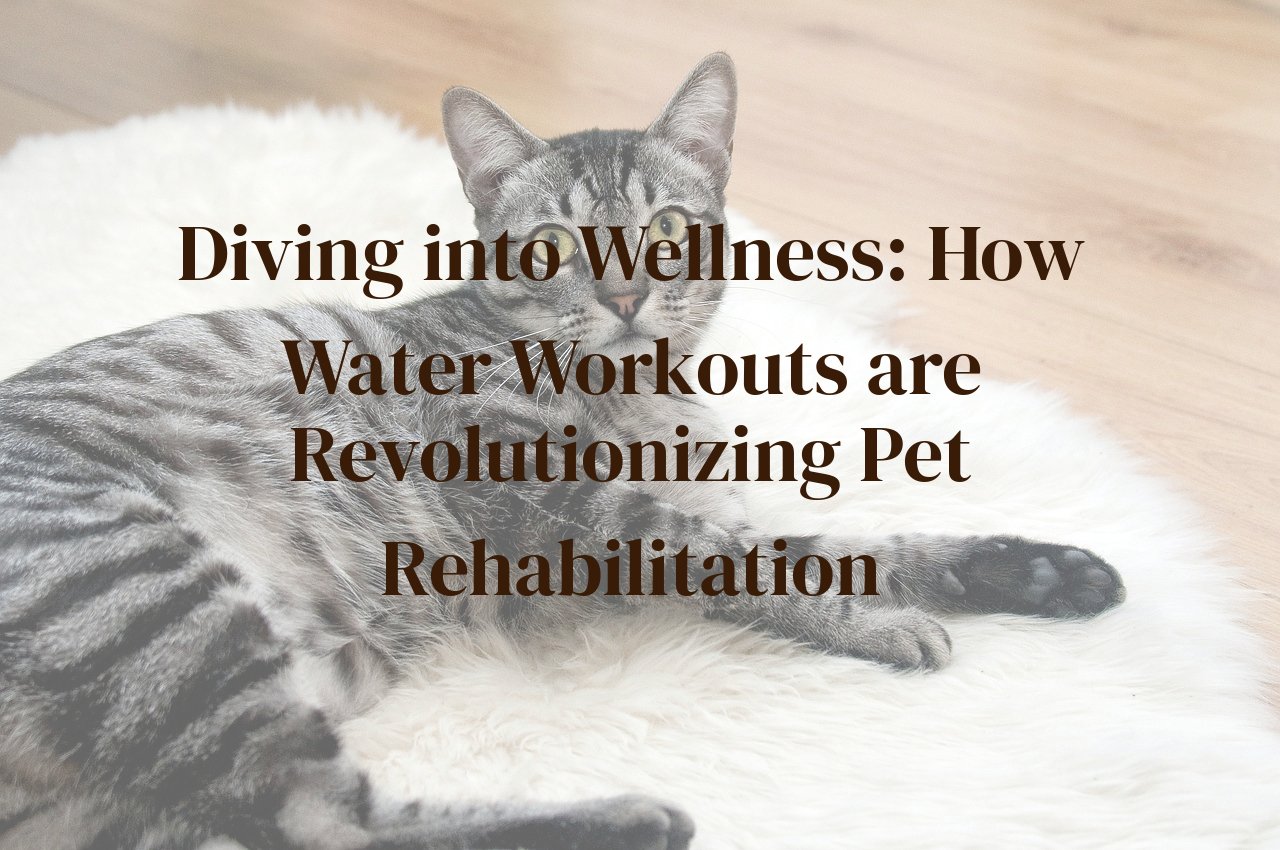
Exploring the depths of veterinary innovation, this post delves into the refreshing world of aquatic therapy—a healing modality making waves in pet care. As a dedicated follower of trends in animal health, I will guide you through the benefits, methods, and success stories associated with this buoyant approach to veterinary well-being. Discover how this gentle, yet impactful, form of therapy is opening up new possibilities for the health and happiness of our cherished companions.
Read on to unearth how aquatic therapy can not only elevate your pet’s quality of life but also provide you with the knowledge to make informed decisions about their care. Join me on this immersive journey as we navigate the waters of a treatment that is setting new benchmarks in veterinary care and pet rehabilitation.
Table of Contents
The Buoyant Benefits of Aquatic Therapy in Pet Care
When I first recommended aquatic therapy to a patient’s owner, the skepticism in her eyes was as clear as the pristine waters we planned to use. Fast forward several weeks, and the transformation in her arthritic Labrador was nothing short of miraculous. The natural buoyancy of water creates an embracing, low-impact environment that gently cradles pets, reducing the stress on their joints and encouraging movement with reduced pain. I fondly recall watching that Labrador paddle with a vigor that belied his years, his tail wagging a watery rhythm of pure joy.
Aquatic therapy harnesses the therapeutic qualities of water to provide a multitude of benefits. The hydrostatic pressure, the force exerted by fluids when at rest, has a natural anti-inflammatory effect that helps reduce swelling and improves circulation. As pets swim or walk on an underwater treadmill, this pressure creates a soothing compression that aids in healing without the need for additional medication. It’s heartwarming to see animals that had shuffled painfully now stride more confidently through the water’s embrace.
The versatility of water workouts is another buoyant benefit I’ve observed. Whether it’s a post-operative pup needing gentle exercise to regain strength or an overweight feline working off those extra tuna treats, aquatic therapy can be tailored to each pet’s needs. The resistance offered by water intensifies their efforts, promoting muscle tone and endurance in a playful splashing session. This regal cat I once assisted transformed from a sedentary fluffball into a sleek swimmer, each stroke another step towards a healthier life.
One cannot overstate the psychological boons. Caring for ailing pets is an emotional journey, and the joy of seeing your furry companion regain their zest for life is profound. Beyond the physical rehabilitation, aquatic therapy serves as a conduit for improving mental well-being. The soothing qualities of water can ease anxiety and promote relaxation, not just for the pets but for their human counterparts as well. The chorus of barks and purrs in my facility’s pool area is a testament to the sheer delight that water therapy brings into their lives.
In my career, championing aquatic therapy in pet care has not only revolutionized rehabilitation but has synergistically healed the hearts of those who love their pets as family. The sight of a once subdued pet bounding forward into the loving arms of their owner, wet and triumphant, is a stark reminder of the life-changing power that resides in these buoyant waters.
Navigating the Waters: How Aquatic Therapy Works for Animals
The moment we immerse our furry patients into the calming embrace of warm water, the magic of aquatic therapy begins. As a veterinary health expert who’s witnessed the transformative power of water, I understand that this form of rehabilitation offers a low-impact workout that’s particularly gentle on recovering bodies. Enlightening my readers on how aquatic therapy operates for animals is not just a matter of listing benefits, but of sharing the intricacies of the healing journey within the water’s buoyant haven.
In aquatic therapy, pets are eased into a specially designed pool or underwater treadmill. Here, the water’s natural buoyancy reduces the gravity’s force, allowing pets with arthritis, injuries, or post-surgical conditions to move more freely than they could on land. This buoyancy supports their weight, reducing stress on aching joints and encouraging a range of motion that might otherwise be too painful. The consistent warmth of the water adds another layer of comfort, promoting increased blood flow to stiff muscles and tender areas.
As a blogger, recounting tales of resilience, I’ve seen the role of controlled hydrostatic pressure in this aquatic domain. This pressure enhances circulation and decreases swelling, amplifying recovery speed. The therapy sessions are tailored to each animal’s specific needs, gradually increasing in duration and intensity as they regain strength. What’s notable in aquatic therapy is the ability of the water to provide a unique form of resistance. Unlike weights or bands that might pose too great a challenge initially, water’s resistance is adaptive—it meets the pet where they’re at, applying a gentle force that builds muscle without overburdening fragile limbs.
Their strides under the water are more than just physical movements; each step is a ripple in the pond of their recovery. Coaxed by the patient guidance of veterinary therapists, animals learn to navigate the therapeutic waters. Some may swim, while others walk or paddle on the submerged treadmill, each movement fortified by the hydrodynamic forces that engage different muscle groups, enhancing overall conditioning and improving cardiovascular health.
Furthermore, the sensory stimulation provided by the water helps in re-educating the nervous system, which is often necessary for pets recovering from neurological damage. In those moments, the splashes aren’t just sounds of progress but echoes of hope, resonating with the healing rhythm of paws against water. To witness a paralyzed pet take its first steps in the pool, or a senior dog swim with newfound zest, is to see the core of aquatic therapy’s heart – where every lap taken is a paddle towards better health and vitality.
Real Waves of Change: Success Stories in Aquatic Pet Therapy
Among the ripples of innovation in pet rehabilitation, aquatic therapy rises as a powerful current of hope and healing. My own journey as a pet health blogger has been rich with tales of transformation, where water has not only rehabilitated but also enriched the lives of many cherished companions. I am always touched by stories like that of Charlie, a golden retriever who found new strength in his weakened limbs, swimming against a gentle current, his tail wagging with each paddle. His recovery from a debilitating hip injury was nothing short of miraculous, showcasing the regenerative powers of hydrotherapy.
Then there’s the heartwarming story of Whiskers, a tabby cat that defied the odds. Cats aren’t known for their love of water, yet Whiskers, having suffered from a rare neurological condition, made incredible strides in an underwater treadmill. It was a sight to behold: the hesitant first steps leading to confident strides, each movement in the water contributing to her remarkable recovery. Whiskers’ success shattered preconceived notions and reminded us that every pet’s potential for healing is as vast as the ocean itself.
The world of aquatic pet therapy is also home to veterans like Duke, a police dog who served honorably before being injured in the line of duty. The wear and tear on his body seemed irreversible until aquatic therapy came into the picture. Duke’s sessions in the pool breathed new life into his old bones. It was pure joy to see this brave canine move without pain, his buoyancy in water lending him a semblance of his youthful spirit.
I also recall the inspirational journey of Bubbles, a portly Corgi, whose story is a testament to the weight management potential of water workouts. Bubbles struggled with obesity, a condition that impaired her mobility and dampened her zest for life. Through a meticulously crafted aquatic therapy program, she shed pounds and her propensity for lounging turned into an eagerness for pool time. Her transformation was not just physical; it ignited a newfound vitality that was infectious to all who knew her.
These cases, and countless others like them, illustrate the profound impact that aquatic therapy can have on the quality of life for our four-legged friends. Each story is a chapter in the ever-growing archive of successes, reflecting the adaptability and resilience of animals when given the chance to thrive through innovative care. Aquatic therapy for pets is more than a new frontier in veterinary care—it’s a celebration of life’s buoyancy, even when faced with the deepest waters of physical ailment.
Setting Up for Success: Integrating Aquatic Therapy into Veterinary Practice
As a proponent of innovative veterinary care, the introduction of aquatic therapy into a veterinary practice must be undertaken with both meticulous planning and genuine passion. The first step in the integration process involves rigorous research and education. Veterinarians and their staff should immerse themselves in understanding the principles of hydrotherapy and its physiological benefits on animal musculature and joint health. Courses and certifications dedicated to aquatic therapy for animals are essential in ensuring that the practice adheres to the highest standards.
Next, designing or selecting the right facility is crucial. The choice between constructing a new hydrotherapy wing or retrofitting an existing space depends on budget and available resources. Regardless of the choice, the facility must meet specific requirements, such as anti-slip floors, ramps or lifts for animal access, and water sanitation systems. Most importantly, the pool or underwater treadmill must accommodate animals of various sizes and needs.
Equipping the team is as important as setting up the space. A successful aquatic therapy program requires skilled therapists, who are not only trained in rehabilitation techniques but also adept at handling animals with care and empathy. Alongside professional training, having a team dedicated to the emotional well-being of pets can significantly enhance the therapeutic experience.
It is also imperative to develop a comprehensive rehabilitation program tailored to each pet’s unique condition. Collaborating closely with pet owners to set realistic goals and providing them with progress updates can foster a cooperative atmosphere conducive to healing. Moreover, integrating technology such as underwater cameras to monitor movement and digital tracking of rehabilitation progress, can greatly advance the success of the therapy.
Lastly, community outreach and education will pave the way for more widespread acceptance of aquatic therapy as a viable treatment modality. By hosting open days, showcasing success stories, and sharing knowledge through seminars and social media, a veterinary practice can build trust and demonstrate its commitment to cutting-edge pet rehabilitation. Integrating aquatic therapy doesn’t just create ripples of change; with the right approach, it creates a tidal wave of improved animal welfare and practice growth.
Flowing into the Future: The Expanding Horizons of Hydrotherapy for Pets
The concept of hydrotherapy has been swirling around the world of human wellness for ages, but it’s truly splashing into the world of veterinary care with invigorated force. As a dedicated blogger in pet care and an avid follower of holistic healing, I’ve been awestruck by the ways in which water has become an ally for our furry friends. The development in this field isn’t just about rehabilitation after injury—it’s about opening a new chapter in proactive and preventive health for pets.
Take the advancements in equipment, for instance. From customizable underwater treadmills to sophisticated resistance pools, our veterinary experts are now equipped with high-tech arsenal specifically designed with our pets’ anatomy in mind. These advances not only provide a more nuanced approach to each pet’s unique needs but also signal an increased interest in the long-term health benefits that hydrotherapy can offer beyond recovery from trauma or surgery.
The rise of mobile hydrotherapy services is another leap toward accessibility and convenience. Nurturing the idea that wellness should come to you, not the other way around, these services have begun to alleviate the stress of transportation for both pets and their owners, which is a significant boon, especially for those with mobility issues or chronic conditions requiring regular sessions.
Aquatic therapy’s use in weight management programs for pets is another tidal shift in its application. The low-impact nature of hydrotherapy is proving to be an excellent option for overweight pets, allowing them to exercise without placing undue stress on their joints, which is a relief I’ve personally witnessed through the transformation stories shared with me by hopeful pet owners.
Lastly, the integration of hydrotherapy into behavioral therapy programs encapsulates the holistic ethos that the future of pet care embodies. Recognizing that the soothing properties of water can calm an anxious pet, veterinary practitioners are increasingly incorporating hydrotherapy into their treatment plans, merging physical and emotional healing in a dance of ripples and waves.
The horizon is indeed promising, and as someone who thrives on witnessing the harmony between pets and their caring owners, the expansion of hydrotherapy signals a future where wellness, in all its liquid grace, is recognized as a fundamental part of our pets’ lives. It’s a future I’m eagerly watching, documenting, and celebrating, one splash at a time.
Conclusion
As we resurface from the informative currents of aquatic therapy for pets, we recognize its transformative potential in the realm of veterinary care. With the knowledge you’ve gathered from this exploration, may you feel empowered to consider these serene waters for your pet’s therapeutic needs. By embracing the new frontiers of hydrotherapy, you not only contribute to the continuous evolution of animal healthcare but also ensure a tide of well-being for your beloved companions.



